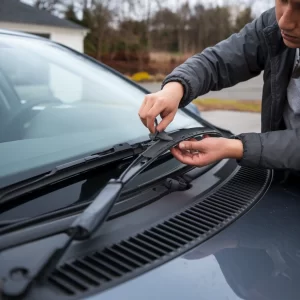Best Way to Change Windshield Wipers
The Importance of Maintaining Windshield Wipers
When was the last time you thought about your windshield wipers? They’re often an afterthought, but these simple tools are vital for maintaining clear visibility during rain or snow. Worn-out wiper blades can smear dirt and water across your windshield, leaving you with a dangerous driving experience. Just like any other part of your vehicle, regular maintenance is crucial. Keeping your windshield wipers in top shape not only enhances your safety but also ensures that you can respond quickly to changing weather conditions while on the road. If you’re wondering how to change windshield wipers effectively, you’ve come to the right place!
Signs That Your Windshield Wipers Need to be Changed
Windshield wipers are your first line of defense against rain, snow, and debris. When they start to fail, it can be a safety hazard.
One obvious sign is streaking. If your blades leave behind lines or water spots, it’s time for a change.
Another indicator is squeaking or chattering noises when in use. This annoying sound suggests the rubber has worn out or become brittle.
If you notice skipping across the windshield during operation, that’s another red flag. Worn-out blades may not make proper contact with the glass anymore.
Check for visible damage like cracks or tears on the rubber itself. These issues compromise their performance and effectiveness considerably.
Pay attention to these signs; they will help maintain clear visibility while driving in challenging conditions.
Steps to Changing Your Windshield Wipers:
Changing your windshield wipers is a straightforward task that can enhance your driving experience significantly.
First, gather the necessary supplies. You will need new wiper blades and possibly a small flathead screwdriver to help with removal.
Next, lift the old wiper blade off the windshield. Look for a release tab on the arm where it connects to the blade. Press or pull this tab gently while sliding the blade off its mount.
Now it’s time to install the new wiper blades. Align them with the attachment point on your wiper arm and slide them in until you hear a click. Ensure they’re securely locked in place.
Lower each wiper blade back onto your windshield carefully. This simple process can save you from poor visibility during rainstorms or snowfalls.
– Gather Supplies
Before diving into the task of changing your windshield wipers, it’s essential to gather all necessary supplies. This will streamline the process and ensure you don’t run back and forth looking for tools.
First, you’ll need new wiper blades that fit your vehicle. Check your car’s manual or online resources to find the correct size.
Next, grab a flathead screwdriver or a pair of scissors if needed. These can help in removing old blades smoothly without causing damage.
A clean microfiber cloth is also useful for wiping down any dirt on the windshield while you’re at it. Keeping everything organized will make this task much quicker.
Don’t forget gloves if you want to keep your hands clean during installation. With these essentials in hand, you’ll be ready to tackle those worn-out wiper blades efficiently!
– Remove the Old Wiper Blades
To remove the old wiper blades, start by lifting the arm away from the windshield. It should hold in a vertical position, giving you easy access to the wiper blade.
Next, locate the release tab or mechanism on your current wiper blade. This is typically found where the blade connects to the arm. Press or slide this tab gently to unlock it.
Once released, pull downwards on the wiper blade to detach it from the arm. Don’t be surprised if some resistance occurs; just ensure you’re applying even pressure while keeping everything aligned.
After removing one side, repeat these steps for the other wiper blade. Take note of how they are positioned as you’ll want your new ones in exactly that spot!
– Install the New Wiper Blades
Installing new wiper blades is straightforward. First, align the blade with your wiper arm. Make sure it’s facing the correct direction for optimal performance.
Next, slide the new blade onto the arm until you hear a click. This sound means it’s securely attached. If you’re using a specific mounting system, ensure that everything lines up perfectly.
After securing one side, repeat this process on the other side of your windshield. Double-check to confirm both blades are firmly in place before testing them out.
Once installed, gently lift each wiper off the glass and let them return to their resting position. This helps verify they’re functioning as intended and won’t leave streaks or gaps when activated.
Tips for Choosing the Right Wiper Blades
When selecting new wiper blades, consider the size. Check your vehicle’s manual or look for a sticker on the driver’s side door jamb to find the correct dimensions.
Material matters too. Silicone blades tend to last longer and perform better in extreme weather compared to traditional rubber ones. They also resist UV damage.
Think about the type of climate you live in. If you’re often battling snow or ice, heavier-duty winter blades designed for these conditions may be necessary.
Brand reputation can influence quality as well. Research popular brands and read customer reviews to gauge performance and longevity.
Don’t overlook installation features. Some wiper blades come with easy clip-on designs that make replacement a breeze, saving you time and hassle during maintenance tasks.
Common Mistakes to Avoid When Changing Wiper Blades
Changing windshield wipers seems simple, but mistakes can lead to poor performance. One common error is not checking the size of the new blades. Always verify that you’re purchasing the correct length for your vehicle.
Another pitfall is failing to clean the wiper arms before installation. Dirt and debris can hinder their function and cause premature wear on new blades.
Many people also overlook proper attachment techniques. Ensure that each blade clicks securely into place; a loose fit might leave streaks or gaps when you need them most.
Using old hardware or clips from previous blades is another misstep. These components may wear out over time, diminishing the effectiveness of your new wipers.
Don’t forget to remove any protective covers on your new blades before use. Skipping this step will prevent them from making full contact with your windshield, leading to inadequate cleaning during rainstorms.
How Often Should You Change Your Windshield Wipers?
Windshield wipers are crucial for safe driving, especially during rain or snow. But how often should you change them? It’s a question many drivers overlook.
Typically, it’s recommended to replace your wiper blades every six months to a year. However, various factors can influence this timeline. If you live in areas with harsh weather conditions—like extreme heat or heavy snowfall—you might need to change them more frequently. 
Pay attention to performance. If you notice streaks on the glass or hear squeaking sounds while in use, it’s time for a replacement.
Regular inspections can prevent last-minute surprises during storms. Keeping an eye on your wipers ensures you’re always ready when the weather turns unpredictable and maintains clear visibility for safer driving conditions.
Conclusion: Properly
When it comes to your vehicle, maintaining functionality is key. Windshield wipers play a crucial role in ensuring you have clear visibility during rain or snow. Neglecting them can lead to dangerous situations on the road.
Changing your windshield wipers doesn’t have to be an overwhelming task. With the right supplies and a bit of guidance, you can easily replace worn-out blades yourself. This not only saves time but also money that would otherwise be spent at a service center.
Remember to look out for signs like streaks on your windshield or squeaking noises when using the wipers as indicators that they need replacement. Regularly changing your wiper blades enhances driving safety and prolongs their lifespan with proper care.
Selecting the correct size and type of blade is essential for effective performance, so take note of manufacturer recommendations or consult store guides while shopping. Additionally, avoiding common mistakes will ensure you install new blades correctly and efficiently.
Making this simple maintenance routine part of your car care checklist will keep things running smoothly whenever inclement weather strikes. Prioritize keeping those windshield wipers fresh; it’s one small step toward safer driving experiences every time you’re behind the wheel.



